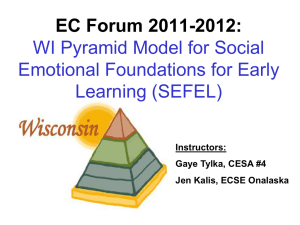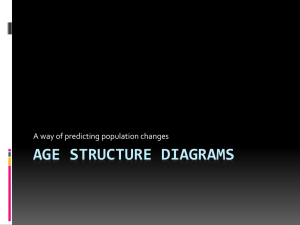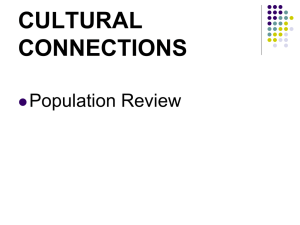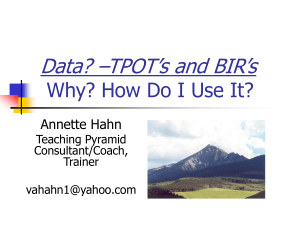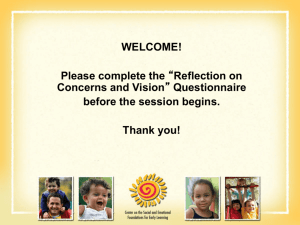Using the Pyramid Model for Promoting Social Emotional
advertisement
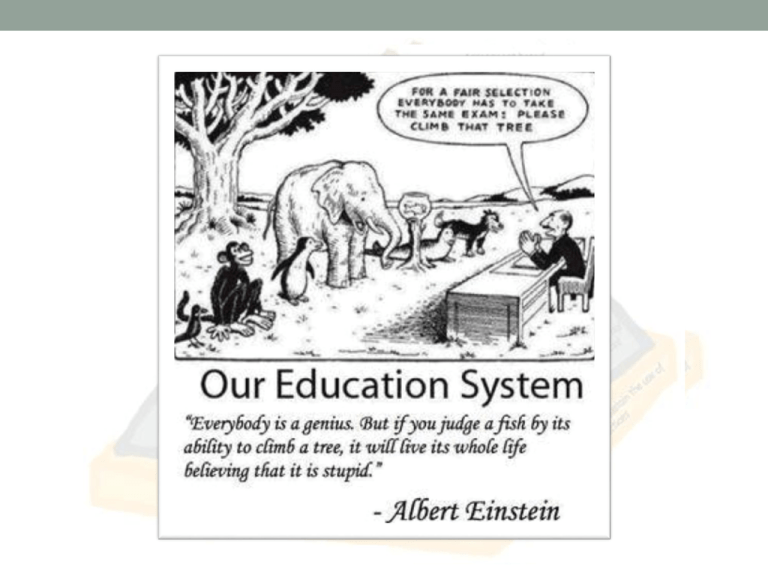
Using the Pyramid Model for Promoting Social Emotional Competence in Young Children GAPBS Annual Conference Presented By Cynthia Vail, PhD, University of Georgia Katy Gregg, PhD, Georgia Southern University Rebecca Sartor, MEd, Clarke County Schools Note on Model and Materials • Much of these materials are used directly from or adapted from the following sources: • Center on the Social Emotional Foundations for Early Learning - CSEFEL • Technical Assistance Center on Social Emotional Intervention- TACSEI Objectives for Today • Describe social emotional skills necessary for young children • Describe the levels of the Pyramid Model for Promoting Social Emotional Competence • Discuss measures of fidelity for the pyramid model • Describe examples of how the pyramid model works in a school-wide approach Key Social Emotional Skills Children Need as They Enter School • Confidence • Capacity to develop good relationships with peers and adults • Concentration and persistence on challenging tasks • Ability to effectively communicate emotions*** • Ability to listen to instructions and be attentive • Ability to solve social problems*** What do children do when they don’t have each of these skills? Challenging Behaviors In the Classroom When children do not have these skills, they often exhibit challenging behaviors. We must focus on TEACHING the skills! Most challenging behaviors are used by children as a way to communicate something. YOU CAN’T NOT COMMUNICATE Any behavior that the child displays or does not display communicates something. The Pyramid Model for Supporting Social Emotional Competence in Young Children Tertiary Intervention: Few Children Secondary Prevention: Some Children Universal Promotion: All Children Foundational Levels (Primary/Universal): Promote Children’s Success • Create an environment where EVERY child feels good about coming to school. • Design an environment that promotes child engagement. Image from K. Gregg – Georgia Southern Child Development Center Teaching Social Emotional Skills (Secondary - Green) Focus on teaching children what To Do! •Teach expectations and routines. •Teach skills that children can use in place of challenging behaviors. Teaching Social Emotional Skills (Secondary– Green) Intensive, Individualized Interventions (Tertiary – Red) Basics of Challenging Behaviors • Children often use challenging behavior when they don’t have the social or communication skills they need to engage in more appropriate interactions. • If you can figure out the • Behavior that persists over time is • Form: Running from circle usually working for the child. • We need to focus on teaching children what to do in place of the challenging behavior. form & the function, you will have a better idea of where to start working with the child to replace the behavior. • For Example: time • Function? • Escape or Attention I’m bored, I’m frustrated, I wanted that toy, I want you to chase me, etc. Importance of Team Approach • Collaboration with all involved • Family support & input, including data collection • Consider health, home, environment, and family dynamics Fidelity Measures for the Pyramid Model • Teaching Pyramid Observation Tool (TPOT) (Fox, Hemmeter, & Snyder)(soon to be published by Brookes) • Designed to measure the practices of teachers using the pyramid model in preschool classrooms • The Pyramid Infant-Toddler Observation Scale (TPITOS)(Carta, et al.) (under field testing) • Designed to measure the practices of teachers and caregivers in Infant/Toddler classrooms TPOT & TPITOS • Both tools use a combination of observation, interview- informed and judgment-based rating scales. • Both tools require a minimum of a 2 hour observation period. • TPOT does not include meal times or outdoor time • TPITOS includes all routines • Both tools are designed to support professional development and can measure growth over time. Old Way – New Way Old Way New Way • General intervention • Intervention matched for all behavior challenges • Intervention is reactive • Focus on behavior reduction • Quick fix to purpose of the behavior • Intervention is proactive • Focus on teaching new skills • Long term interventions Challenges and Triumphs of School Wide Implementation Triumphs • It works!! • Higher assessment scores and overall student behavior • Higher success rates of children in kindergarten Challenges and Triumphs of School Wide Implementation Challenges • Time for training and planning • Funding for support personnel Where to start when I leave here? • Start with a Self-Assessment • The Inventory of Practices for Promoting Children's Social Emotional Competence “If a child doesn’t know how to read, we teach.” “If a child doesn’t know how to swim, we teach.” “If a child doesn’t know how to multiply, we teach.” “If a child doesn’t know how to drive, we teach.” “If a child doesn’t know how to behave, we… … teach?… punish?” “Why can’t we finish the last sentence as automatically as we do the others?” –Tom Herner (NASDE President ) Counterpoint 1998, p.2
